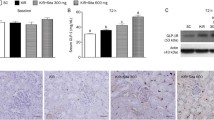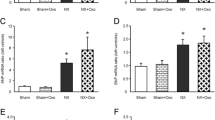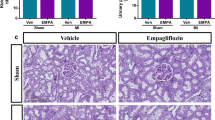Abstract
The post myocardial infarction (MI) mortality rate is high in renal patients. One possible explanation is the reduced ischemia tolerance caused by uraemia. Previous investigations showed larger MI size in uraemic rats when compared with sham-operated controls. To explore a possible link between uraemic insulin resistance syndrome and MI size in uraemia, we studied an intervention model with administration of insulin and glucose during acute MI in subtotally nephrectomized (SNX) rats and sham-operated controls. In 16 SNX rats and 16 sham-operated controls, the left coronary artery was ligated for 60 min, followed by reperfusion for 90 min. To visualize the perfused myocardium, lissamine-green ink was injected. The nonperfused area (lissamine exclusion) and the area of total infarction (TTC stain) were assessed in sections of the left ventricle (LV) using image analysis. While eight SNX rats and eight sham-operated controls were treated with a placebo during the procedure, the other animals received an insulin bolus of 85 mU/kg and then a continuous insulin infusion of 8 mU/kg per minute. Blood glucose levels were clamped to baseline levels with an infusion of 25% glucose. Insulin receptor substrates (IRS-1 and IRS-2) and glucose transporter (GLUT 4) were studied by western blot in another seven SNX and seven sham-operated controls without further intervention. The infarcted area, given as a proportion of the nonperfused risk area, was not different in sham-operated controls treated with a hyperinsulinaemic clamp versus untreated (0.55 ± 0.07 vs. 0.51 ± 0.13, p = 0.477). The eight SNX animals treated with the hyperinsulinaemic clamp utilized significantly less glucose to stabilize baseline glucose levels when compared with the sham-operated controls (5,637 vs. 3,207 μl Glc 25%, p = 0.007). The infarcted area was significantly lower in SNX rats treated with the hyperinsulinaemic clamp compared to non-treated SNX animals (0.56 ± 0.06 vs. 0.79 ± 0.09, p < 0.001). SNX rats with the insulin clamp had the same infarcted area size as sham-operated controls (0.56 ± 0.06 vs. 0.51 ± 0.13, p = 0.357). Western blotting did not show any change in the expression of GLUT 4 and IRS-1/IRS-2 in SNX animals when compared with sham-operated controls. The size of MI in uraemic rats is significantly reduced by a glucose/insulin infusion. The results suggest an insulin resistance in uraemic rats with similar benefits of glucose/insulin application during acute MI, as found in diabetic individuals. Further analysis did not reveal a down regulation in GLUT 4 and IRS-1/IRS-2.





Similar content being viewed by others
References
Abel ED (2004) Glucose transport in the heart. Front Biosci 9:201–215
Alvestrand A (1997) Carbohydrate and insulin metabolism in renal failure. Kidney Int 62:48–52
Amann K, Wiest G, Zimmer G, Gretz N, Ritz E, Mall G (1992) Reduced capillary density in the myocardium of uremic rats—a stereological study. Kidney Int 42:1079–1085
Amann K, Breitbach M, Ritz E, Mall G (1998) Myocyte/capillary mismatch in the heart of uremic patients. J Am Soc Nephrol 9:1018–1022
Amann K, Tyralla K, Gross ML, Schwarz U, Tornig J, Haas CS, Ritz E, Mall G (2003) Cardiomyocyte loss in experimental renal failure: prevention by ramipril. Kidney Int 63:1708–1713
Bartnik M, Norhammar A, Ryden L (2007) Hyperglycaemia and cardiovascular disease. J Intern Med 262:145–156
Becker B, Kronenberg F, Kielstein JT, Haller H, Morath C, Ritz E, Fliser D (2005) Renal insulin resistance syndrome, adiponectin and cardiovascular events in patients with renal disease: the Mild and Moderate Kidney Disease Study. J Am Soc Nephrol 16:1091–1098
Berger J, Biswas C, Vicario PP, Strout HV, Saperstein R, Pilch PF (1989) Decreased expression of the insulin-responsive glucose transporter in diabetes and fasting. Nature 340:70–72
Boland R, Matthews C, de Boland AR, Ritz E, Hasselbach W (1983) Reversal of decreased phosphorylation of sarcoplasmic reticulum calcium transport ATPase by 1, 25-dihydroxycholecalciferol in experimental uremia. Calcif Tissue Int 35:195–201
Chakraborty C (2006) Biochemical and molecular basis of insulin resistance. Curr Protein Pept Sci 7:113–121
DeFronzo RA, Alverstrand A, Smith D, Hendler R, Hendler E, Wahren J (1981) Insulin resistance in uremia. J Clin Invest 67:563–572
Dikow R, Kihm LP, Zeier M, Kapitza J, Tornig J, Amann K, Tiefenbacher C, Ritz E (2004) Increased infarct size in uremic rats: reduced ischemia tolerance? J Am Soc Nephrol 15:1530–1536
Eidemak I, Feldt-Rasmussen B, Kanstrup IL, Nielsen SL, Schmitz O, Strandgaard S (1995) Insulin resistance and hyperinsulinaemia in mild to moderate progressive chronic renal failure and its association with aerobic work capacity. Diabetologia 38:565–572
Fliser D, Pacini G, Engelleiter R, Kautzky-Willer A, Prager R, Franek E, Ritz E (1998) Insulin resistance and hyperinsulinemia are already present in patients with incipient renal disease. Kidney Int 53:1343–1347
Fliser D, Kielstein JT, Menne J (2006) Insulin resistance and renal disease. Contrib Nephrol 151:203–211
Friedman JE, Dohm GL, Elton CW, Rovira A, Chen JJ, Leggett-Frazier N, Atkinson SMJ, Thomas FT, Long SD, Caro JF (1991) Muscle insulin resistance in uremic humans: glucose transport, glucose transporters, and insulin receptors. Am J Physiol 261:E87–E94
Herzog CA, Ma JZ, Collins AJ (1998) Poor long-term survival after acute myocardial infarction among patients on long-term dialysis. New Engl J Med 339:799–805
Ju JS, Gitcho MA, Casmaer CA, Patil PB, Han DG, Spencer SA, Fisher JS (2006) Potentiation of insulin-stimulated glucose transport by the AMP-activated protein kinase. Am J Physiol 292:C564–C572
Kato Y, Hayashi M, Ohno Y, Suzawa T, Sasaki T, Saruta T (2000) Mild renal dysfunction is associated with insulin resistance in chronic glomerulonephritis. Clin Nephrol 54:366–373
Kennedy D, Omran E, Periaramy SM, Nadoor J, Priyadarshi A, Willey JC, Malhotra D, Xie Z, Shapiro JL (2003) Effect of chronic renal failure on cardiac contractile function, calcium cycling, and gene expression of proteins important for calcium homeostasis in the rat. J Am Soc Nephrol 14:90–97
Malmberg K (1997) Prospective randomised study of intensive insulin treatment on long term survival after acute myocardial infarction in patients with diabetes mellitus. DIGAMI (Diabetes Mellitus, Insulin Glucose Infusion in Acute Myocardial Infarction) Study Group. BMJ 314:1512–1515
Malmberg K, Norhammar A, Wedel H, Ryden L (1999) Glycometabolic state at admission: important risk marker of mortality in conventionally treated patients with diabetes mellitus and acute myocardial infarction: long-term results from the Diabetes and Insulin-Glucose Infusion in Acute Myocardial Infarction (DIGAMI) Study. Circulation 99:2626–2632
Matthews C, Heimbarg KW, Ritz E, Agostini B, Fritzsche J, Hasselbach W (1977) Effect of 1, 25-dihydroxycholecalciferol in impaired calcium transport by the sarcoplasmic reticulum in experimental uremia. Kidney Int 11:227–235
Pantos C, Mourouzis I, Dimopoulos A, Markakis K, Panagiotou M, Xinaris C, Tzeis S, Kokkinos AD, Cokkinos DV (2007) Enhanced tolerance of the rat myocardium to ischemia and reperfusion injury early after acute myocardial infarction. Basic Res Cardiol 102:327–333
Raine AEG, Seymour AML, Roberts AFC, Radda GK, Ledingham JGG (1993) Impairment of cardiac function and energetics in experimental renal failure. J Clin Invest 92:2934–2940
Reaven GM (2005) Compensatory hyperinsulinemia and the development of an atherogenic lipoprotein profile: the price paid to maintain glucose homeostasis in insulin-resistant individuals. Endocrinol Metab Clin North Am 34:49–62
Ritz E, Koch M (1993) Morbidity and mortality due to hypertension in patients with renal failure. Am J Kidney Dis 21:113–118
Shinohara K, Shoji T, Emoto M, Tahara H, Koyama H, Ishimura E, Miki T, Tabata T, Nishizawa Y (2002) Insulin resistance as an independent predictor of cardiovascular mortality in patients with end-stage renal disease. J Am Soc Nephrol 13:1894–1900
Skyschally A, Schulz R, Heusch G (2008) Pathophysiology of myocardial infarction: protection by ischemic pre- and postconditioning. Herz 33:88–100
Tian R, Abel ED (2001) Responses of GLUT4-deficient hearts to ischemia underscore the importance of glycolysis. Circulation 103:2961–2966
Towler MC, Hardie DG (2007) AMP-activated protein kinase in metabolic control and insulin signaling. Circ Res 100:328–341
Vareesangthip K, Tong P, Wilkinson R, Thomas TH (1997) Insulin resistance in adult polycystic kidney disease. Kidney Int 52:503–508
Wang C, Hu SM (1991) Developmental regulation in the expression of rat heart glucose transporters. Biochem Biophys Res Commun 177:1095–1100
Zhang C, Park Y, Picchi A, Potter BJ (2008) Maturation-induces endothelial dysfunction via vascular inflammation in diabetic mice. Basic Res Cardiol 103:407–416
Author information
Authors and Affiliations
Corresponding author
Rights and permissions
About this article
Cite this article
Dikow, R., Wasserhess, C., Zimmerer, K. et al. Effect of insulin and glucose infusion on myocardial infarction size in uraemic rats. Basic Res Cardiol 104, 571–579 (2009). https://doi.org/10.1007/s00395-009-0018-2
Received:
Revised:
Accepted:
Published:
Issue Date:
DOI: https://doi.org/10.1007/s00395-009-0018-2




